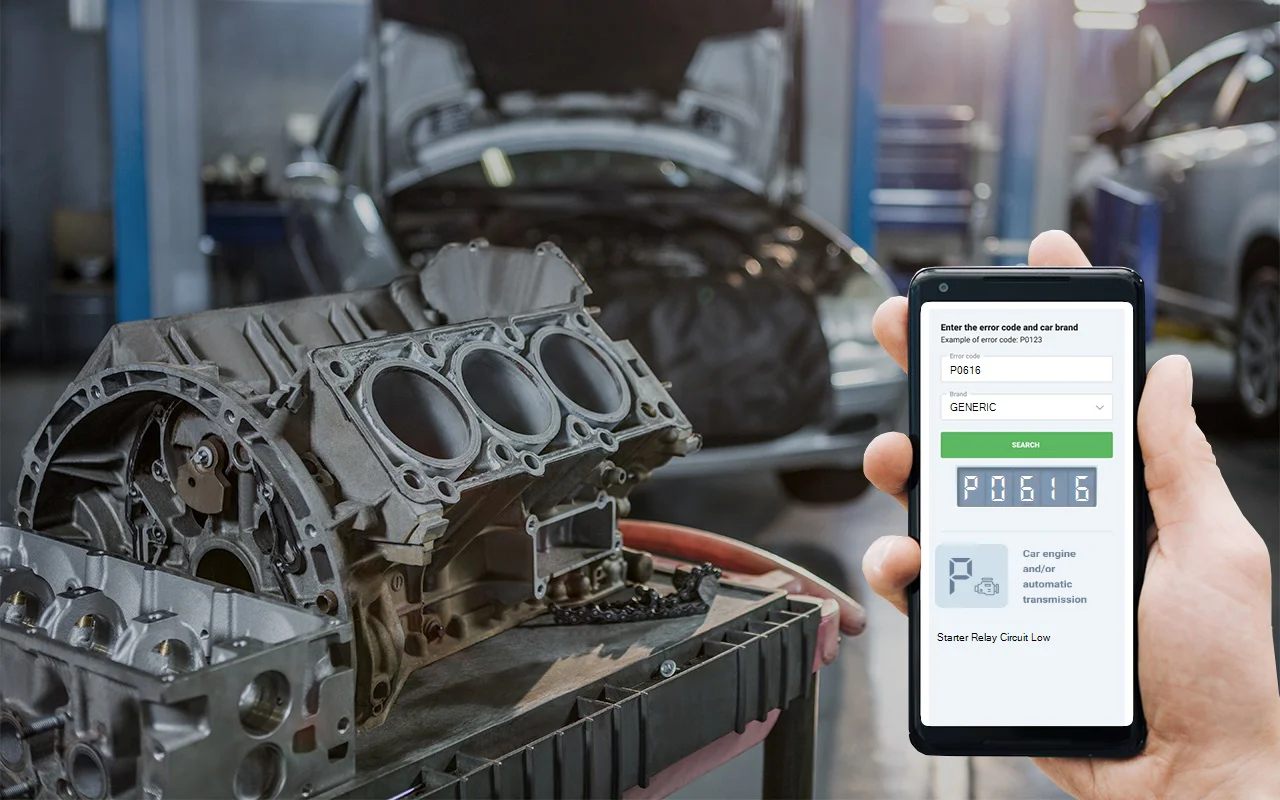When you see a P0616 code, you’re dealing with a starter relay circuit issue-something I’ve run into plenty of times in the bay. In plain English, this circuit is what lets your car’s computer (the PCM) send juice to your starter so your engine actually cranks over. The players in this circuit? Ignition switch, fuses, starter relay, starter solenoid, battery cables, and sometimes a clutch or neutral safety switch, depending on your setup. The PCM throws the P0616 code when it senses a weak voltage or something off in this circuit. In real-world terms, your car might suddenly refuse to start, or it may only fire up every now and then. I’ve seen this code pop up across all sorts of vehicles-the fundamentals are usually the same, but every make and model does things a little differently under the hood.
DTC P0616
Causes of P0616 engine code
From experience, the most common reasons I see for a p0616 code are issues right in the starter circuit. Here’s what usually causes it:
- Faulty ignition switch
- Bad starter relay
- Defective starter solenoid
- Blown fuse or fusible link (if your car uses one in this circuit)
- Corroded or damaged connectors
- Corrosion or damage on battery cables
- Broken or shorted wiring in the starter circuit
- Bad PCM (rare, but possible)
- Starter motor failure
Most often the issue is with wiring, connectors, or the relay itself, but I’ve seen all of these pop up in the shop.
Symptoms of obd code P0616
If you’ve got this code, here’s what you’re likely to notice-these are the red flags I look for when a car rolls into my garage:
- The engine won’t crank or start at all
- Sometimes it’ll start, sometimes it won’t (intermittent no-start)
- Check Engine light is on
Honestly, the full no-start is what I see most. Sometimes, it’ll tease you and fire up after a few tries, but that’s your warning sign-things are only going to get worse from there.

Diagnosis steps for obd2 code P0616
When I’m faced with a P0616, here’s my step-by-step game plan-these are the steps that’ve saved me hours of chasing ghosts over the years:
- First, I always check for any Technical Service Bulletins (TSBs) related to the starter circuit for your specific make and model. Sometimes there’s a known issue or updated procedure that can save a lot of time.
- Next, I look at the fuses related to the starter relay circuit. If there’s a blown fuse, that’s a big clue-just be sure to find out why it blew before replacing it.
- After that, I do a thorough visual inspection. I check all the wiring and connectors from the battery to the starter, relay, ignition switch, and PCM. I’m looking for things like corrosion, loose connections, burnt spots, or frayed wires. Don’t forget to check the battery terminals-they need to be clean and tight.
- Then, I test the starter relay itself. Swapping it with a known good relay (if you have one) is a quick way to rule it out. You can also test it with a multimeter if you’re comfortable.
- If everything looks good so far, I check for voltage at the starter and relay terminals while someone turns the key to ‘start’. If there’s no voltage, the problem is likely upstream-maybe the ignition switch or wiring. If there is voltage but the starter doesn’t engage, the starter or solenoid could be bad.
- For wiring checks, I use a multimeter to test for continuity (with the battery disconnected). Any resistance or open circuit means there’s a break or corrosion in the wire that needs fixing.
It’s best to have someone help you turn the key while you check voltages, and always make sure the car is in park or neutral for safety.

Common mistakes when fixing P0616 code
A classic mistake I see is jumping straight to replacing the starter or even the PCM, without bothering to check the wiring or connectors. That’s a quick way to throw money down the drain. Another one? Overlooking a blown fuse or a crusty battery terminal. Always start with the basics-simple stuff like fuses and connections-before you even think about dropping cash on the big-ticket parts.

Seriousness of dtc P0616
Let me be blunt: you really don’t want to ignore this one. If your car won’t start, you’re stuck-no two ways about it. Even if it’s just acting up occasionally, it’s only a matter of time before you’re left stranded. Plus, every failed start attempt with a janky circuit puts extra strain on your starter, solenoid, and, in rare cases, the PCM. My advice? Fix it before you’re forced to deal with an even bigger headache.
Repair tips for P0616 trouble code
Over the years, here’s what’s actually solved a p0616 for me, and what you’ll find in the official repair procedures too:
- Replace a faulty ignition switch
- Swap out a blown fuse or fusible link (and fix the root cause)
- Clean or repair corroded connectors
- Repair or replace damaged wiring
- Replace bad battery cables or terminals
- Install a new starter relay
- Replace the starter solenoid or the starter itself if they’re bad
- In rare cases, reprogram or replace the PCM
Here’s a pro-tip from the garage: Always start with the cheapest, easiest fixes-like fuses and connectors-before moving on to the expensive stuff.
Conclusion
Bottom line: A P0616 code means your car’s computer can’t properly control the starter relay, and chances are you’ll be facing a no-start situation. Don’t drag your feet on this-being stuck somewhere isn’t worth it. Get started with the basics: fuses, wiring, and connectors. Nine times out of ten, fixing a bad wire or relay will get you back in business. And if you’re unsure, don’t hesitate to call in a pro before shelling out for a pricey part you might not actually need.




